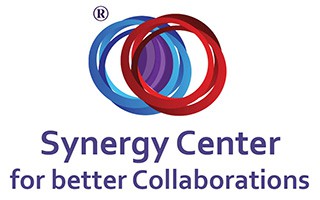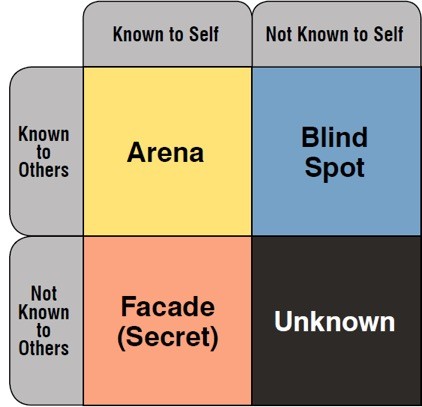Communication is a crucial management skill. Knowing what to communicate to whom at what time ensures timely and regular communication. Interactions depend on communication – but there’s an interdependence between boundaries and communication. There is plenty of tools for teamwork or group work development, or for improvement of communication between employees.
Synergy can develop easily when communication pattern is fusion – not one- or two-way communication. There are tools, which encourage fusion communication, and these include, but not limited to, heartfelt, non-violent, assertive, or transformative meditation patterns of communication. These tools can serve the organization good. Let’s have a look at two good tools.
The Johari Window
This tool gives you an opportunity to examine yourself deeply in relation to others. And so, the tool requires the user to choose from a list nouns, which accurately describe their personalities, and the personalities of people whom they relate with. In an organization, you relate to your workplace colleagues. Then, you can combine your own choice of nouns with that of your colleagues. Afterwards, there’s an attempt to create a connection between your choice of nouns and that of your colleagues. Four quadrants capture this relationship as follows:
- The arena quadrant – opens up about information you and your colleagues know.
- The blind spot quadrant – reveals information about what your colleagues know about you, which you don’t know.
- The secret (façade) quadrant – reveals information about what you know, which your colleagues don’t know.
- The unknown quadrant – reveals information which neither you nor your colleagues know about.
The Johari Window intends to improve communication between you and your colleagues. And so, it encourages flexible (fusion) communication patterns, because it attempts to increase knowledge of information that you and your colleagues know about – the arena. Thus, it encourages information sharing, but that would largely depend on your willingness to share knowledge.
The point is, the tool intends to increase arena and reduce secret. Moreover, since everyone may be unable to see their mistakes unless pointed out by others, it’s important to encourage your colleagues to offer you feedback about your blind spot. This would help expand the arena.

Above: The Johari Window

Above: The Johari Window after expanding arena, reducing secret and receiving feedback about your blind spot.
This process doesn’t happen overnight – it takes time. Getting people to open up is easier said than done. Believe it or not, people find it difficult to share their personal stories, especially if they prefer to live private lives. Nonetheless, personal exposure can create connections, which can be helpful in organizations.
Usually, organizations have a culture in which employees, especially senior managers, are unwilling to share stories about their personal lives. Sharing of information and feedback between employees is a spiral process. You’re not a robot – you’re a human being. We all have weaknesses. Keeping secret is an energy-consuming process. The Johari Window can help you save that energy, directing it elsewhere where it’s required.
You must learn how to create a conducive circumstance, which would encourage a meaningful conversation. Then, you can demand for a genuine feedback about your blind spot. Just as you receive feedback, so would others expect it from you. Importantly, everyone must feel comfortable to share knowledge, as this would ensure the deepness of the process. For more information, read the book The Johari Window by Hase, Davies and Dick.
The Listening Circle
This is an interesting tool, which originated from the culture of the Native Americans. It demonstrates the workings of synergy in teams and shared actions. Christina Baldwin and Margaret Wheatley, together with their colleagues, popularized the tool through their writings.
The Listening Circle intends to strengthen the infrastructure of organizations by leveraging connections, cooperation for common good, group pride, trust, support, and compassion, all of which encourage synergy formation. In addition, it’s one of the most useful tools to start a discourse about diversity issues. It can complement useful tools like the “massage exercise” and open offices.
It’s a go-to tool, especially if you intend to strengthen your team, instill respect and structure relationships. People find it uncomfortable to share personal stories, because of feelings of insecurity, tension, unwillingness to cooperate, lack of attention, and lack of creativity. The tool can remove these feelings, enabling flexible communication to take place.
How to Preside Over a Listening Circle
As had been mentioned earlier, the Listening Circle can help you initiate a conversation – safely – about diversity issues – or any pertinent topic in your organization. First of all, if you’re a team supervisor, invite your team members to a sitting in a circle. The seating arrangement should be circular, so that everyone can face each other. Just be sure to observe the following rules when presiding over the occasion:
- There must be an object, which grants members of the circle a permission to speak. Only one person can speak at a time, and they must hold the object – no interruption. The object can be anything, but it must be unique or identifiable. This rule ensures quality speaking and listening; hence, quality of discussion. This helps to cultivate the habit of listening more than speaking. In the end, meaning and understanding is successfully transferred, because disruption of communication is disallowed.
- The golden rule is “speaking and listening from the heart” in a respectful manner, regardless of the speaker’s diversity. Any form of prejudice or bias toward the speaker is discouraged. Importantly, the listeners must attempt to connect with what the speaker is saying. In synergy terms, this behavior is respect to diversity.
- The presider should encourage speakers to go straight to the point – no beat around the bush. The speaker should be straightforward and brief – they should give a summary of the key points they’d like to share with others. It’s important to note that the Listening Circle isn’t a session to pour out burdensome thoughts by any means. This can disrupt listening. The speaker must focus on what they want to say. In this way, the speaker respects the listeners.
- The listeners shouldn’t preplan their responses when the speaker is speaking. The listener should give a natural response. This encourages attention to what’s being said, so that the listeners can respond to what’s been said.
It can be challenging to communicate what’s on your mind. Breathing techniques can help you overcome this obstacle. Taking a deep breath before you share something can it easy for you speak your mind when your turn to speak arrives. It’s alright to say what comes first on your mind. Avoid selecting your thoughts as an intellectual.
At first, the circle may be unpopular, but as people get a hang of it, you’ll get more members. It’s good to organize the circle periodically. The circle isn’t a one-off session. The circle’s effectiveness increases over time. In the long-run, the session can contribute to the improvement of interactions between employees of your organization. Furthermore, it contributes to more flexible boundaries and fusion communication patterns.
In Brief…
Communication involves transfer of meaning and understanding. And so, it’s a crucial management skill. Good communication favors synergy, and improves quality of interactions between employees of an organization. The Listening Circle and the Johari Window are useful communication tools, which you can leverage to start a conversation about anything that’s pertinent to your organization.



